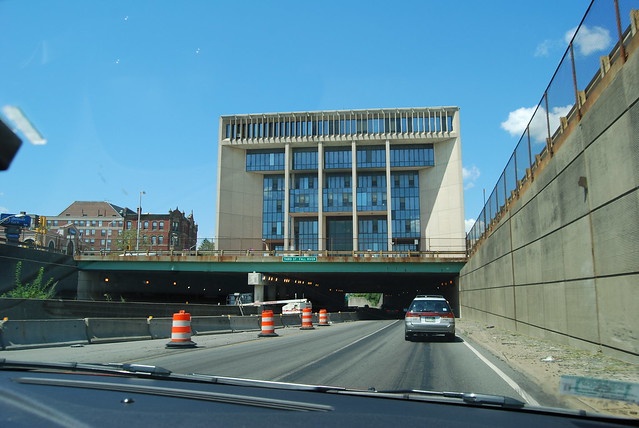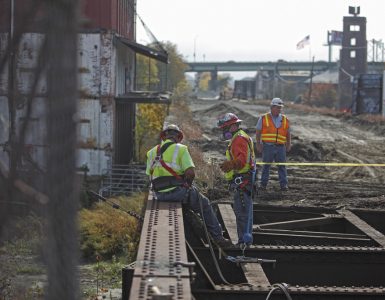Fall River City Hall photo by twentysixcats from Flickr
PBN reported yesterday about Massachusetts moving forward on environmental review of three proposals for transit options between Boston and Fall River and New Bedford.
- Commuter rail through Attleboro: Fall River and New Bedford would gain access to South Station via a new bypass track through Norton and Attleboro to the Northeast Corridor. The study will evaluate both electric and diesel trains.
- Commuter rail through Stoughton, the state’s preferred route: Fall River and New Bedford would gain service to South Station via a new link through Stoughton; an option might extend service to the Whittenton section of Taunton. Electric and diesel options will be evaluated.
- Rapid bus: Fall River, New Bedford and Taunton would gain access to Boston via a dedicated, mostly-reversible bus lane that would be constructed along Route 24 and Interstate 93 / 128. The proposed bus service also would use the existing I-93 high-occupancy vehicle (HOV) “zipper” lane, and for a short portion of its trip, would travel through mixed traffic.
The option to route trains to Fall River and New Bedford via the Middleborough/Lakeville line seems to have been dropped.
The Stoughton option is the preferred and would likely provide the most direct and fastest service between the two South Coast cities and Boston. The Stoughton alternative faces stiff opposition from some towns along the route, most notably Easton. There are also environmental groups concerned about reactivating existing rail lines through sensitive wetlands.
The Attleboro alternative is potentially interesting in the future for connecting the South Coast to Providence. Though Route 195 is most direct, the Attleboro alignment would open the possibility of having service from Providence to New Bedford and/or Fall River. Service along the Attleboro alignment could also run from Providence, through Taunton and on to Middleborough, Buzzards Bay, and the Cape.
The third option, “rapid bus” is a non-starter in my eyes. First, a train can transport far more passengers than a bus or collection of buses. Secondly, even if fully built out, part of the “rapid bus” route would run in mixed traffic on clogged local highways. Third, the cost of building special lanes on Route 195, 24, and 93 would be better spent on rail infrastructure. If the “rapid bus” option was chosen, surely in 20 years the Commonwealth would again be discussing rail.
Now, the bus option actually could start running now as it will still be some years before trains depart from New Bedford and Fall River. Get bus services running now to build a passenger base that can be transitioned to the trains when they come online. I favor this for Rhode Island too. We should be running coaches from Quonset and Wickford through the airport and into Providence and Attleboro, creating the service that will eventually become the South County Commuter Rail.
Another thing to keep in mind from the Rhode Island perspective when it comes to South Coast rail is Newport. Plans are afoot to run a rail shuttle on Aquidneck Island. The Sakonnet River rail bridge has been removed, meaning that any island rail service will have to stay on the island. However, bridges can be rebuilt and the rail line runs right into Battleship Cove, where the Fall River Commuter Rail station is proposed. A Newport shuttle could provide commuter services for people from the island to transfer to the T in Fall River. It can also be used for tourist transit. Have Newport visitors leave their cars in Fall River (maybe visit Battleship Cove), then jump on a shuttle to Newport. Visitors from Boston could take the T to Fall River to hop on the island shuttle.





Rapid Bus, sheesh. Implementation of bus service has no impact on land use patterns or development prospects. Only rail infrastructure can do that. If the bus stops are at the interchanges the usage will be strictly park and ride, stimulating no redevelopment in the towns. If the bus gets off the highway to trundle in and out of the walkable areas there will be nothing rapid about it.
To the extent that opponents in Easton are pointing to the sprawl of mcmansions on 5 acre lots that the Middleboro and Kingston extensions brought about, I certainly sympathize with them. What is the answer? 100 acre lot minimums? Not all transit-enabled development happens to be what we like – TOD.
To the extent that they just want to keep out the riffraff, a class of people that conveniently overlaps with the class of families that can not afford to maintain a fleet of vehicles, shame on them.
Nice to know the T is at least thinking about electric locomotives.
Oh right! I totally forgot I wanted to mention that in my post. Electrification of the south side fleet is indeed much needed. Think of how much more pleasant Providence and Back Bay stations would be without diesel trains stinking the places up.
Electric locomotives can also supply faster service. They are lighter, so they stop quicker and get back up to speed quicker, reducing dwell time at station stops.
The possibility of electrification is really big news. The MBTA would not even consider it before, despite the fact that one line already has wires (Providence), another would be a pretty trivial extension (Stoughton), and it would be pretty cheap to add a third (Needham). It would really improve the commuter service. And hey, if they add high platforms too, maybe we can see Providence-Boston service in under an hour. It’s in Amtrak’s own best interest to have the MBTA do this, btw, because the closer the speed of the commuter rail is to the Regional, the more trains they can fit on the line in total.
The bus alternative, though it seems more cost-effective, completely ignores the cost of widening all of the bridge openings on 24 to accommodate an added lane in each direction, and the cost of improving all the interchanges (many of which are already substandard) so they have adequate accelleration and decelleration lanes.
I can’t believe a state that is cutting the buses, trains and ferry it provides now because we, the taxpayers can’t pay for it, wants to build even more trains that we won’t be able to pay for. Also when discussing the Stoughton alternative why is it never mentioned that in August 2007 the Department of transportation stated that new rail crossings at grade level are not recommended. All crossings need to have grade separation in order to provide safety to the residents. I guess the safety of the residents of Easton, Stoughton, Canton,and Raynham, don’t matter as long as New Bedford and Fall River get a train.
South Coast gets $20 million in stimulus funds to work on bridges to prepare for Commuter Rail.
This is great news for Fall River and New Bedford. However, another missing rail link not even on the edge of the radar screen is connecting rail service to the metropolitan area the two cities are part of|Providence. The Providence/Fall River/New Bedford metropolitan area is one of, if not the poorest metro regions in southern New England. One of the reasons is a transit disconnect. Providence is closer to Fall River than it is to South County or Newport and Boston is further from its two south coast cities than it is to Providence. Aside from the Providence to Boston commuter rail link parochial attitudes between the three states persist and in particular between Massachusetts and Rhode Island. The congressional delegations from the three states should come together to propose an interstate transit authority that can provide seamless service (rail and bus) between all three states without obstacles to benefit all parts of the region equally.
Perhaps, I overreacted missing the later part of this article when I wrote the previous comment. However, an interstate transit authority is crucial for creating a balanced regional system. By the way, for a brief period in the 1980s Amtrak had a separate train between Providence and the Cape.
South Coast commuter rail pilloried by communities along route [Providence Business News]
Hmmm, I wonder what the real issue is here.
Might this reaction be a local version of the anti-rail sentiment that’s been appearing around the country. Raynham, Stoughton and Easton are suburban and heavily auto-centric. Is there a conservative element in these towns?
The real issue is that wealthy people in Easton and Raynham have built huge houses adjacent to the old rail bed, thinking it would never be active again.
The wetlands disruption would be minimal as most of the right-of-way is already graded. Destruction of historic districts? They must be referring to downtown Easton, where a historic train station would be used again. I fail to see how that is destructive!
I don’t want to think it could have something to do with “those people” being able to get to their town on the train.
Past arguments have included “those people.” I’ve also heard “people in Fall River and New Bedford could never get Boston jobs anyway” and “drug dealers from Fall River will get off in [Easton, Raynham, Stoughton] and sell to our children!”
Economic development!
Not to mention that I know plenty of former children from those towns (I work on the South Shore) and none of them ever had any problem going to find drugs on their own. So, it’s also a safety issue. Buy drugs in the safety of the train station! No more going to Brockton!
What I find especially amusing are the NIMBY’s who are using environmental arguments as their basis to object to the project. They all keep clamouring about effects on the Hockomock Swamp. Only 0.5 acres of wetlands in the swamp would be affected, and they would be replicated at least 2:1 anyway.